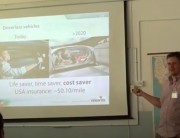As early as 1929, Ray Davis Kell described a form of video compression and was granted a patent for it. He wrote, “It has been customary in the past to transmit successive complete images of the transmitted picture. [...] In accordance with this invention, this difficulty is avoided by transmitting only the difference between successive images of the object.” Although it would be many years before this technique would actually be used in practice, it is still a cornerstone of many video compression standards today. It’s the reason why video using MPEG can be compressed roughly a factor of 10 better than JPEG-compressed still images.
What technique can provide another magnitude of improvement in video compression?
My prediction is that we need to change focus from optimizing for best peak signal to noise performance to optimizing for psycho-visual perception. I.e. “how good do the compressed images look” instead of looking at minimizing the mathematical difference between the original and compressed imagery.






